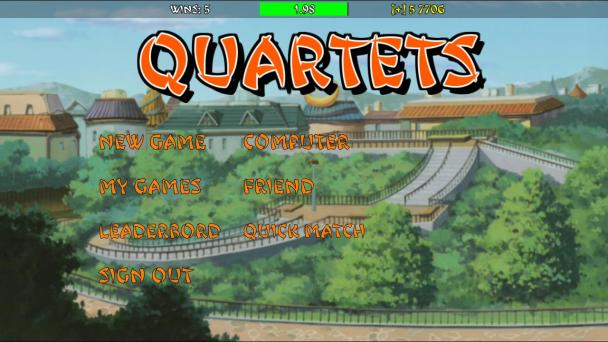About this app
The “Quartets” is a real interesting and exciting game. There is total 36 cards (9 families and in every of them have 5, 4 or 3 cards). Each card has a number and letter (1A, 2A, 3A, 1E, 2E, 3E, 4E, etc.). In the beginning every player has 8 cards, plus any one card out of the game, and remaining 19 lie concealed in the stack. Player get card from the stack before his turn. On the bottom of the screen you see your cards, in the top there are opponent’s cards. Goal of the game is to collect as many quartets as you can get (5, 4 or 3 cards in the same family. Each player has 12 health points.
At first, you select any group cards, what you want collect. The cards that you have are blacked, the cards that you need are light. Next you select a card. You asks opponent for a card, and if the opponent has this card, you get it. And you can repeat the action with the follow cards. You can continue asks the cards from another groups when you finish collect one group of cards. But if opponent doesn't have this card your turn ends and in this moment your opponent gets one card from stack and does the same to you. When you are selecting card to ask from opponent remember: you have to complete quartet – five, four or three cards from the same family.
When a quart is created, or a complete quart was dealt, then your opponent lost his health points. Quantity of lost health points depend of quantity the cards in the quart. For example, you collect quart with 5 cards, so your adversary lost 5 health points.
If adversary has a card that you asked for this card will be yours. After that your turn continues. You have to analyze your situation again and select family and card to ask for. But if he doesn't have this card your turn ends and in this moment your opponent gets one card from stack. Then its opponents turn - he asks for a card. If you have it you lose it and he asks for another card. If you don't have card that he asks, opponent turn ends and you get one card from stack.
The most important for you is to remember what cards opponent ask for and what cards he took from you. For example, if he asks for A1, it means that he has minimum one card with A (A2 and/or A3). It also means that in this moment he doesn't have this card. Memorizing what he took from you is also important - you know what cards you have to get back. Remember that when you are asking cards from your opponent you can ask only about cards families that you have.
We have some interesting actions in the game. Click the “Health Points” button. You can use the “Show History”, when you want to see history turns of you and your opponent. Do you want to take an additional card from the stack? So, choose the “Draw a Card”! Maybe, do you wish steal any card adversary? Select the “Steal a Card” action. At last, you can use the “KAMIKAZE”, that to destroy the health point of your adversary. You can use the “End a Turn” to skip a turn.
Game finishes when one from players loses all his health points. The winner is the person which has the health point(s).
The game recalls game a «Sea Battle». In this game you know what ships (cards) exist, but you don’t know what ships (cards) are at the adversary. This is the familiar from the childhood to all of us.
Our game gets more fun in multiplayer battles with the Google Play Games. You can play with friends or random opponent from the whole world in real-time. You can compete with your friends on leaderboards, track your achievements
This unofficial fan app was created to honor the best anime and manga series ever - Naruto (ナルト).
Naruto (ナルト) is a Japanese manga series written and illustrated by Masashi Kishimoto. It tells the story of Naruto Uzumaki, an adolescent ninja who constantly searches for recognition and dreams to become the Hokage and his friends Sasuke, Sakura, Kakashi and other!
App Permissions
Allows applications to open network sockets.
Allows applications to access information about networks.
Allows read only access to phone state, including the phone number of the device, current cellular network information, the status of any ongoing calls, and a list of any PhoneAccounts registered on the device.
Allows applications to access information about Wi-Fi networks.
Allows an application to write to external storage.
Allows an application to record audio.
Allows an application to read from external storage.

